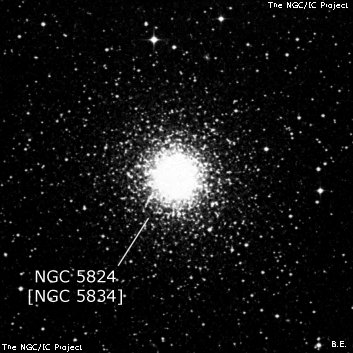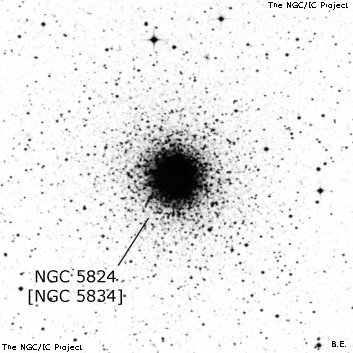NGC/IC Project Restoration Effort
(This is a very very beta version)
NGC5824


Basic Information
Location and Magnitude
Right Ascension: 15:3:58.5
Declination: -33:4:2
Constellation: LUP
Visual Magnitude: 9.1
Historic Information
Discoverer: Dunlop
Year of discovery: 1826
Discovery aperture: 9.0
Observational
Summary description: pB, S, stell, N
Sub-type: I
Corwin's Notes
=====
NGC 5824 = NGC 5834. Here is an interesting case in which Dreyer reveals his
bias for his senior colleague from Great Britian, and against a younger one
from Tennessee. But the younger persisted, and proved himself correct.
JH's position (from his Slough sweep number 353 on 9 May 1831; curiously,
there is no trace of this in his Cape Observations) is out by 2.4 minutes of
time, and 3.5 arcmin; the position is not marked uncertain in any way. His
description is also unusual in that it says only, "A very strongly suspected
nebula; but I cannot be quite sure (from the low situation) it is not a star."
He translated this to "eeF(?)" for the GC, and Dreyer went right along with
that in the NGC, too.
Barnard first observed this object in 1882, and had four micrometric
measurements for it by 1886 when he published a note about it in AN 2756 (he
has another earlier note in Sidereal Messenger 3, 189, 1884 correcting the
description, but quoting JH's incorrect position). The resulting position
agrees with the modern positions to within a few arcseconds. Barnard also
noted the brief, incorrect description in the GC, saying that "The nebula is
small and very bright with a decided nucleus."
Dreyer rejected Barnard's identification of the object as GC 4036, listing
both it and JH's observation, giving both objects NGC numbers. Another oddity
is Dreyer's parenthetical inclusion of Marth's brief note that JH's object is
"B, stellar" (I've not yet traced Marth's note). Unfortunately, Dreyer has no
other note in the NGC about the two entries, so Barnard's object stands there
as a "new" one, while JH's continues on with the wrong coordinates.
Barnard was evidently annoyed by this, and published a second note in AN 2995
(1890) with yet more micrometric measurements, this time from Lick Observatory
where he had just taken a job as one of the resident astronomers. This second
position is accordant with his first to within a few arcsec, but Barnard gives
more details here, noting that the object is probably a globular cluster of
10th magnitude about 3/4 to 1 arcmin in diameter. He also notes that the
object must have been quite bright if JH was to have swept it up in the
southern sky just six degrees above his horizon at Slough.
This time, Dreyer got the point. So, in the IC1 Notes, he asks that NGC 5834
"be struck out" as it is identical to NGC 5824. Since there is nothing at
JH's position, and nothing else in the area that he might have seen, the
identity is assured.
Finally, Glen Cozens has suggested that the cluster may have been seen by
James Dunlop, too. If Dunlop's RA for his number 611 is corrected by 1.8
minutes of time (21 arcmin) it would match that for the cluster.
Steve's Notes
=====
NGC 5824
17.5" (6/3/00): moderately bright globular, small, ~2.5' diameter. Contains a sharply concentrated 1' core that is very prominent, surrounded by a symmetric 2.5' halo. No definite resolution at 500x although the halo is mottled and one or two "sparkles" were glimpsed (one at the SE end of halo).
8" (6/27/81): small, bright core.



